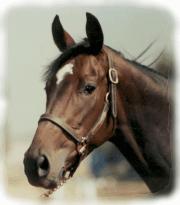A Horse, of Course with Don Blazer |
If you enjoy learning about horses, then you'll love our online courses. Each month you'll find a new column on our web site. We hope you'll enjoy it, and maybe e-mail us with questions or suggestions for other columns. A Horse, Of Course is a monthly column syndicated by Success Is Easy. If you like the column, call your local newspaper, or local horse publication and ask them to subscribe by contacting Success Is Easy. |
Big Isn't Better Don Blazer copyright©2010 Big, big, big. Phooey! What's this preoccupation with big horses? "I want a big horse," says the dude. "Why?" asks the cowboy. "I don't know," says the dude, "I've always looked up to 'em." Does this silliness come from the misconceived, but familiar phrase, "A good horse is better than a good little horse?" Big isn't better. By definition, big is "large." Better is "more desirable, more useful, of superior quality." But better isn't big unless you desire something exclusively for its size. Let's look at horses for what they are as individuals, both big and little. Does a big horse carry weight better? Not necessarily. The ability to carry weight is controlled by a number of factors, including length and conformation of the spine, muscle system, conformation and soundness of legs and feet. It's the little burro who usually gets stuck with packing the baggage. Can a big horse run faster than a smaller one? No. It's been proven scientifically that it's not the length of stride which determines speed, but the individual horse's ability to retract his stride. The horse extends the leg in forward motion, but just before putting his foot on the ground he retracts it. It's not how quickly he picks them up; it's how quickly he puts them down. Is the big horse healthier? No. Rapid growth and excessive size contribute significantly to all of the unsoundness caused by concussion. How do you determine the size of a horse? Most references and horsemen use the standard of 14.2 hands as the division between horses and ponies. A "hand" measures 4 inches, so a 14.2 hand horse is 58 inches at the withers. Today a 14.2 hand horse is considered to be small and just about every serious horseman, no matter what the breed he prefers will tell you, "I like 'em big." It's even true with pony people. Show records at least on the West Coast, indicate larger ponies usually come out on top in halter classes when height classification lines are crossed. Yet there is nothing to prove good conformation is granted by height. Let's look at the past, the time when horses really had to work. The knights in their shining armor rode big horses. But the days of the knights were short lived. Unless the dragon stood still or the enemy knight rode straight at you, you were bound to get into trouble. It's true the big horses carried a lot of weight then, and later, but it's also true they didn't do it very well. Sir Walter Gilbey wrote a book entitled, "Small horses in Warfare." In it, he cited example after example of how horses 13.2 to 14.3, out- performed big horses in nearly every endeavor. He wrote that during the Crimean War, horses-all under 14.3- ridden by Armenian and Bashi Bazouks, consistently performed, "beyond the capabilities of the English Thoroughbred cavalry." Gibley also told the marches of the British regiment in Sudan, in which the 14 hand horses were "marvels of endurance." D. Peschkof, a Cossack, left Blagovestchensk, Siberia, in November of 1889. He and his tack weighted 180 pounds, but he rode his pony, which was only 12.3 hands, 5,478 miles in 193 days. The pony, named Seri, crossed Siberia in the winter and averaged 37 miles per day. Incredible! So, if big horses aren't more durable, quicker, healthier, or better weight carriers, what are they? They are good at pulling. There's no doubt that when it comes to hauling cannons, combines or heavy wagons, big horses are best. But there are exceptions. Justin Morgan was only 14 hands, yet he out trotted, out ran and out pulled horses much larger than himself. In addition, he founded a breed, an accomplishment that no big horse has achieved. Actually, all draft horses are descendants of the Tundra Pony, heavily muscled and standing about 13.2 hands. Big isn't better. It's just a fad. Unfortunately, there are a lot of little horses being overlooked for the worst reason of all. The looker knows big, but not better. Visit A Horse, Of Course on the Internet at www.donblazer.com |
